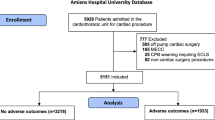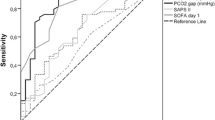Abstract
Central venous oxygen saturation (ScvO2) is easily observable in oncology patients with long-term central venous catheters (CVC), and has been studied as a prognostic factor in patients with sepsis. We sought to investigate the association between ScvO2 and early complications in cancer patients presenting to the ED. We prospectively enrolled adult cancer patients with pre-existing CVC who presented to the ED. ScvO2 was measured on their CVC. The outcome was admission to the intensive care unit (ICU) or mortality by day 7. ScvO2 was first studied as a continuous variable (%) with a ROC analysis and as a categorical variable (cut-off at < 70%) with a multivariate analysis. A total of 210 cancer patients were enrolled. At baseline, ScvO2 showed no significant difference between patients who were admitted to the ICU or died before day 7, and patients who did not (67%; IQR 62–68% vs. 71%; IQR 65–78% respectively, P = 0.3). The ROC analysis showed the absence of discrimination accuracy for ScvO2 to predict the outcome (AUC = 0.56). By multivariate analysis, ScvO2 < 70% was not associated with the outcome (OR 1.67; 95% CI 0.64–4.36). Variables that were associated with ICU admission or death by day 7 included a shock-index (heart rate/systolic blood pressure) > 1 and a performance status > 2 (OR 4.76; 95% CI 1.81–12.52 and OR 6.23, 95% CI 2.40–16.17, respectively). This study does not support the use of ScvO2 to risk stratify cancer patients presenting to the ED.



Similar content being viewed by others
References
Taboulet P, Moreira V, Haas L, Porcher R, Braganca A, Fontaine JP, Poncet MC (2009) Triage with the French Emergency Nurses Classification in Hospital scale: reliability and validity. Eur J Emerg Med 16:61–67
Rady MY, Smithline HA, Blake H, Nowak R, Rivers E (1994) A comparison of the shock index and conventional vital signs to identify acute, critical illness in the emergency department. Ann Emerg Med 24:685–690
Ait-Oufella H, Lemoinne S, Boelle PY, Galbois A, Baudel JL, Lemant J, Joffre J, Margetis D, Guidet B, Maury E, Offenstadt G (2011) Mottling score predicts survival in septic shock. Intensive Care Med 37:801–807
Shapiro NI, Howell MD, Talmor D, Nathanson LA, Lisbon A, Wolfe RE, Weiss JW (2005) Serum lactate as a predictor of mortality in emergency department patients with infection. Ann Emerg Med 45:524–528
Bloos F, Reinhart K (2005) Venous oximetry. Intensive Care Med 31:911e3
van Beest P, Wietasch G, Scheeren T, Spronk P, Kuiper M (2011) Clinical review: use of venous oxygen saturations as a goal—a yet unfinished puzzle. Crit Care 15:232
Hartog C, Bloos F (2014) Venous oxygen saturation. Best Pract Res Clin Anaesthesiol 28:419–428
Angus DC, Barnato AE, Bell D, Bellomo R, Chong CR, Coats TJ, Davies A, Delaney A, Harrison DA, Holdgate A, Howe B, Huang DT, Iwashyna T, Kellum JA, Peake SL, Pike F, Reade MC, Rowan KM, Singer M, Webb SA, Weissfeld LA, Yealy DM, Young JD (2015) A systematic review and meta-analysis of early goal-directed therapy for septic shock: the ARISE, ProCESS and ProMISe Investigators. Intensive Care Med 41:1549–1560
Boulain T, Garot D, Vignon P, Lascarrou JB, Desachy A, Botoc V, Follin A, Frat JP, Bellec F, Quenot JP, Mathonnet A, Dequin PF (2014) Clinical Research in Intensive Care and Sepsis Group: prevalence of low central venous oxygen saturation in the first hours of intensive care unit admission and associated mortality in septic shock patients: a prospective multicentre study. Crit Care 18:609
Pope JV, Jones AE, Gaieski DF, Arnold RC, Trzeciak S, Shapiro NI (2010) Emergency Medicine Shock Research Network (EMShockNet) Investigators: multicenter study of central venous oxygen saturation (ScvO2) as a predictor of mortality in patients with sepsis. Ann Emerg Med 55:40–46
Mazzone A, Dentali F, La Regina M, Foglia E, Gambacorta M, Garagiola E, Bonardi G, Clerici P, Concia E, Colombo F, Campanini M (2016) Clinical features, short-term mortality, and prognostic risk factors of septic patients admitted to internal medicine units: results of an Italian Multicenter Prospective Study. Medicine 95:e2124
Seymour CW, Gesten F, Prescott HC, Friedrich ME, Iwashyna TJ, Phillips GS, Lemeshow S, Osborn T, Terry KM, Levy MM (2017) Time to treatment and mortality during mandated emergency care for sepsis. N Engl J Med 376:2235–2244
Seymour CW, Liu VX, Iwashyna TJ, Brunkhorst FM, Rea TD, Scherag A, Rubenfeld G, Kahn JM, Shankar-Hari M, Singer M, Deutschman CS, Escobar GJ, Angus DC (2016) Assessment of clinical criteria for sepsis: for the third international consensus definitions for sepsis and septic shock (Sepsis-3). JAMA 315:762–774
Singer AJ, Ng J, Thode HC Jr, Spiegel R, Weingart S (2017) Quick SOFA scores predict mortality in adult emergency department patients with and without suspected infection. Ann Emerg Med 69:475–479
Freund Y, Lemachatti N, Krastinova E, Van Laer M, Claessens YE, Avondo A, Occelli C, Feral-Pierssens AL, Truchot J, Ortega M, Carneiro B, Pernet J, Claret PG, Dami F, Bloom B, Riou B, Beaune S, French Society of Emergency Medicine Collaborators Group (2017) Prognostic accuracy of Sepsis-3 criteria for in-hospital mortality among patients with suspected infection presenting to the emergency department. JAMA 317:301–308
Kristensen AK, Holler JG, Hallas J, Lassen A, Shapiro NI (2016) Is shock index a valid predictor of mortality in emergency department patients with hypertension, diabetes, high age, or receipt of β- or calcium channel blockers? Ann Emerg Med 67:106–113
Berger T, Green J, Horeczko T, Hagar Y, Garg N, Suarez A, Panacek E, Shapiro N (2013) Shock index and early recognition of sepsis in the emergency department: pilot study. West J Emerg Med 14:168–174
Park YJ, Kim DH, Kim SC, Kim TY, Kang C, Lee SH, Jeong JH, Lee SB, Lim D (2018) Serum lactate upon emergency department arrival as a predictor of 30-day in-hospital mortality in an unselected population. PLoS One 13:e0190519
Shetty AL, Thompson K, Byth K, Macaskill P, Green M, Fullick M, Lander H, Iredell J (2018) Serum lactate cut-offs as a risk stratification tool for in-hospital adverse outcomes in emergency department patients screened for suspected sepsis. BMJ Open 8:e015492
Rodriguez RM, Greenwood JC, Nuckton TJ, Darger B, Shofer FS, Troeger D, Jung SY, Speich KG, Valencia J, Kilgannon JH, Fernandez D, Baumann BM (2018) Comparison of qSOFA with current emergency department tools for screening of patients with sepsis for critical illness. Emerg Med J 35(6):350–356. https://doi.org/10.1136/emermed-2017-207383
Ouchi K, Hohmann S, Goto T, Ueda P, Aaronson EL, Pallin DJ, Testa MA, Tulsky JA, Schuur JD, Schonberg MA (2017) Index to predict in-hospital mortality in older adults after non-traumatic emergency department intubations. West J Emerg Med 18:690–697
Moore JX, Akinyemiju T, Bartolucci A, Wang HE, Waterbor J, Griffin R (2018) A prospective study of cancer survivors and risk of sepsis within the REGARDS cohort. Cancer Epidemiol 55:30–38
Brown J, Grudzen C, Kyriacou DN, Obermeyer Z, Quest T, Rivera D, Stone S, Wright J, Shelburne N (2016) The emergency care of patients with cancer: setting the research agenda. Ann Emerg Med 68:706–711
Greene J (2015) CONCERN for cancer: new National Institutes of Health network to focus on cancer patients in the emergency department. Ann Emerg Med 66:13A–15A
Boehm K, Duckheim M, Mizera L, Groga-Bada P, Malek N, Kreth F, Gawaz M, Zuern CS, Eick C (2018) Heart rate variability for rapid risk stratification of emergency patients with malignant disease. Support Care Cancer 26:3289–3296
Coyne CJ, Le V, Brennan JJ, Castillo EM, Shatsky RA, Ferran K, Brodine S, Vilke GM (2017) Application of the MASCC and CISNE risk-stratification scores to identify low-risk febrile neutropenic patients in the emergency department. Ann Emerg Med 69:755–764
Rivers E, Nguyen B, Havstad S, Ressler J, Muzzin A, Knoblich B, Peterson E, Tomlanovich M, Early Goal-Directed Therapy Collaborative Group (2001) Early goal-directed therapy in the treatment of severe sepsis and septic shock. N Engl J Med 345:1368–1377
Bracht H, Hänggi M, Jeker B, Wegmüller N, Porta F, Tüller D, Takala J, Jakob SM (2007) Incidence of low central venous oxygen saturation during unplanned admissions in a multidisciplinary intensive care unit: an observational study. Crit Care 11:R2
Sasko B, Butz T, Prull MW, Liebeton J, Christ M, Trappe HJ (2015) Earliest bedside assessment of hemodynamic parameters and cardiac biomarkers: their role as predictors of adverse outcome in patients with septic shock. Int J Med Sci 12:680–688
Mato AR, Luger SM, Heitjan DF, Mikkelsen ME, Olson E, Ujjani C, Jacobs S, Miltiades AN, Shah P, Schuster SJ, Carroll M, Chauffe AD, Fuchs BD (2010) Elevation in serum lactate at the time of febrile neutropenia (FN) in hemodynamically-stable patients with hematologic malignancies (HM) is associated with the development of septic shock within 48 hours. Cancer Biol Ther 9:585–589
Schiffer CA, Mangu PB, Wade JC, Camp-Sorrell D, Cope DG, El-Rayes BF, Gorman M, Ligibel J, Mansfield P, Levine M (2013) Central venous catheter care for the patient with cancer: American Society of Clinical Oncology clinical practice guideline. J Clin Oncol 31:1357–1370
Kopterides P, Bonovas S, Mavrou I, Kostadima E, Zakynthinos E, Armaganidis A (2009) Venous oxygen saturation and lactate gradient from superior vena cava to pulmonary artery in patients with septic shock. Shock 31:561–567
Author information
Authors and Affiliations
Contributions
OP, GD, JPF and EA made the study concept and design; OP, LL, AP, JF, MS, AV, JA, HM, AB, AG acquired the data; OP analyzed and interpreted the data; OP, JPF and EA drafted the manuscript; LL, AP, JF, MS, AV, JA, HM, AB, AG, MRR, JPF and EA made critical revision of the manuscript for important intellectual content; MRR gave statistical expertise.
Corresponding author
Ethics declarations
Conflict of interest
The authors declare that they have no conflict of interest.
Statement of human and animal rights
The study was approved by the regional Ethics Committee.
Informed consent
Informed consent was obtained from all individual participants included in this study.
Rights and permissions
About this article
Cite this article
Peyrony, O., Dumas, G., Legay, L. et al. Central venous oxygen saturation is not predictive of early complications in cancer patients presenting to the emergency department. Intern Emerg Med 14, 281–289 (2019). https://doi.org/10.1007/s11739-018-1966-z
Received:
Accepted:
Published:
Issue Date:
DOI: https://doi.org/10.1007/s11739-018-1966-z




